Microsoft AZ-104試験情報と無料練習テスト問題で合格せよ
2023年最新のの問題AZ-104問題集で更新されたMicrosoft試験問題集を試そう
試験は、仮想ネットワーク、Azure AD、ストレージ管理、仮想マシン、およびAzure Automationなど、Azure管理に関連する広範なトピックをカバーしています。試験はまた、Azure Security Center、Azureポリシー、およびAzure Identity Managementなどのセキュリティとコンプライアンスに関連するトピックもカバーしています。
Microsoft AZ-104 認定試験は、Microsoft Azure 管理の専門知識を証明したいプロフェッショナル向けに設計されています。この試験は、多様な組織によって国際的に認められている Microsoft Certified: Azure Administrator Associate 認定の一部であり、候補者の Azure ソリューションの実装、管理、監視に関する知識とスキルを試験します。
質問 # 146
Hotspot Question
You have an Azure subscription named Subscription1. Subscription1 contains two Azure virtual machines named VM1 and VM2.
VM1 and VM2 run Windows Server 2016. VM1 is backed up daily by Azure Backup without using the Azure Backup agent.
VM1 is affected by ransomware that encrypts data.
You need to restore the latest backup of VM1.
To which location can you restore the backup? To answer, select the appropriate options in the answer area.
NOTE: Each correct selection is worth one point.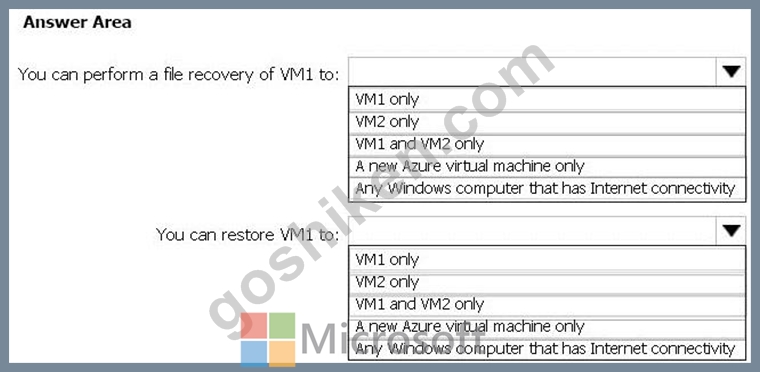
正解:
解説: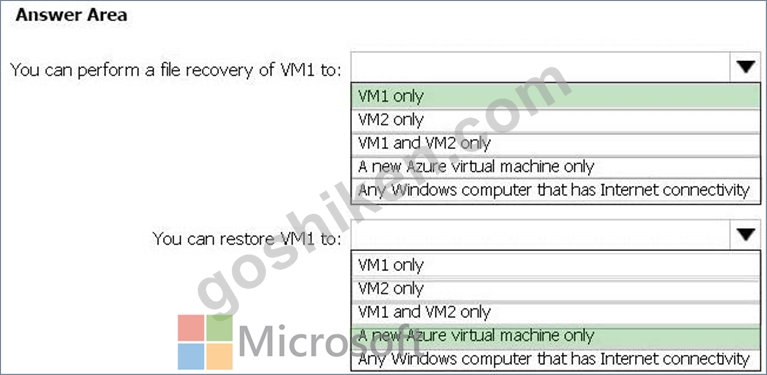
Explanation:
Box 1: VM1 only
To restore files or folders from the recovery point, go to the virtual machine and choose the desired recovery point.
Box 2: A new Azure virtual machine only
On the Restore configuration blade, you have two choices:
Create virtual machine
Restore disks
References:
https://docs.microsoft.com/en-us/azure/backup/backup-azure-restore-files-from-vm
https://docs.microsoft.com/en-us/azure/backup/backup-azure-arm-restore-vms
質問 # 147
You enable password reset for contoso.onmicrosoft.com as shown in the Password Reset exhibit (Click the Password Reset tab.)
You configure the authentication methods for password reset as shown in the Authentication Methods exhibit. (Click the Authentication Methods tab.) For each of the following statements, select Yes if the statement is true. Otherwise, select No.
NOTE: Each correct selection is worth one point.
You enable password reset for contoso.onmicrosoft.com as shown in the Password Reset exhibit (Click the Password Reset tab.) You configure the authentication methods for password reset as shown in the Authentication Methods exhibit. (Click the Authentication Methods tab.) For each of the following statements, select Yes if the statement is true. Otherwise, select No.
NOTE: Each correct selection is worth one point.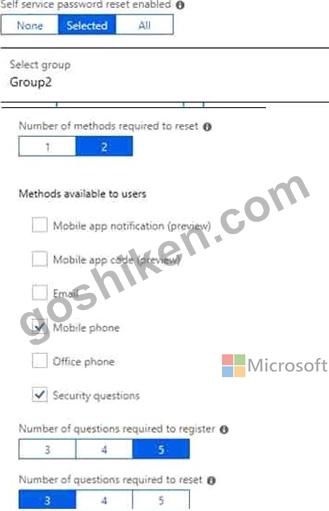

正解:
解説:
Explanation:
Box 1: No
Two methods are required.
Box 2: No
Self-service password reset is only enabled for Group2, and User1 is not a member of Group2.
Box 3: Yes
As a User Administrator User3 can add security questions to the reset process.
References:
https://docs.microsoft.com/en-us/azure/active-directory/authentication/quickstart-sspr
https://docs.microsoft.com/en-us/azure/active-directory/authentication/active-directory-passwords-faq
質問 # 148
You have an Azure Active Directory (Azure AD) tenant named contoso.onmicrosoft.com that contains the users shown in the following table.
You enable password reset for contoso.onmicrosoft.com as shown in the Password Reset exhibit. (Click the Password Reset tab.) You configure the authentication methods for password reset as shown in the Authentication Methods exhibit. (Click the Authentication Methods tab.: For each of the following statements, select Yes if the statement is true. Otherwise, select No.
NOTE: Each correct selection is worth one point.
正解:
解説:
質問 # 149
You have an Azure subscription that contains a virtual network named VNet1. VNet1 uses an IP address space of 10.0.0.0/16 and contains the subnets in the following table.
Subnet1 contains a virtual appliance named VM1 that operates as a router.
You create a routing table named RT1.
You need to route all inbound traffic to VNet1 through VM1.
How should you configure RT1? To answer, select the appropriate options in the answer area.
NOTE: Each correct selection is worth one point.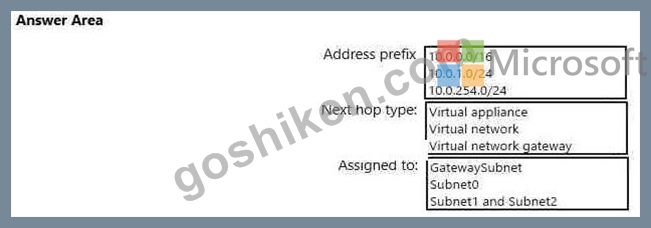
正解:
解説: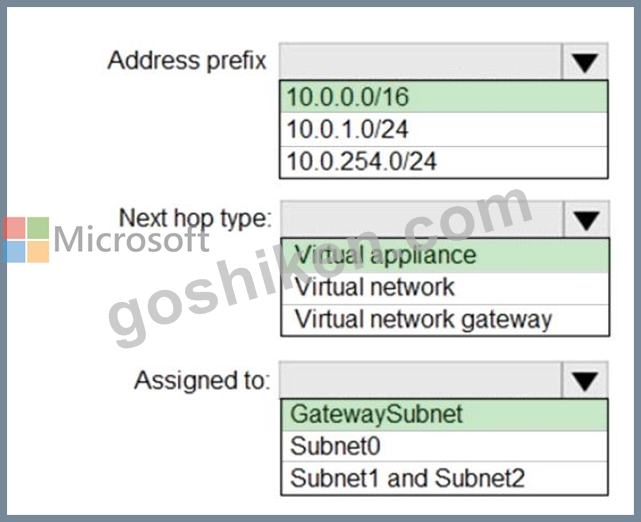
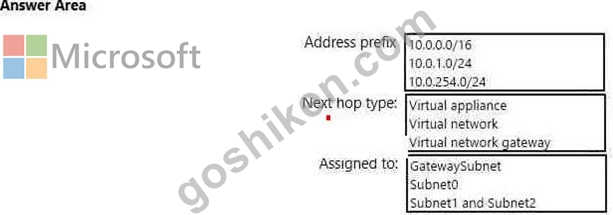
Box1 : 10.0.0.0/16
Address prefix in networking refer to the destination IP address range. In this scenario, destination is Vnet1 , hence Address prefix will be the address space of Vnet1.
Box 2 : Virtual appliance
Next hop gets the next hop type and IP address of a packet from a specific VM and NIC. Knowing the next hop helps you determine if traffic is being directed to the intended destination, or whether the traffic is being sent nowhere Next Hop --> VM1 --> Virtual Appliance (You can specify IP address of VM 1 when configuring next hop as virtual appliance) Box 3 : GatewaySubnet In the scenario it is asked for all the inbound traffic to Vnet1. Inbound traffic is flowing through SubnetGW. You need to route all inbound traffic from the VPN gateway to VNet1 through VM1.So its traffic from Gateway subnet only.
Reference:
https://docs.microsoft.com/en-us/azure/virtual-network/manage-route-table#create-a-route-table
https://docs.microsoft.com/en-us/azure/network-watcher/network-watcher-next-hop-overview
質問 # 150
You have an Azure subscription named Subscription1.
In Subscription1, you create an Azure file share named share1.
You create a shared access signature (SAS) named SAS1 as shown in the following exhibit.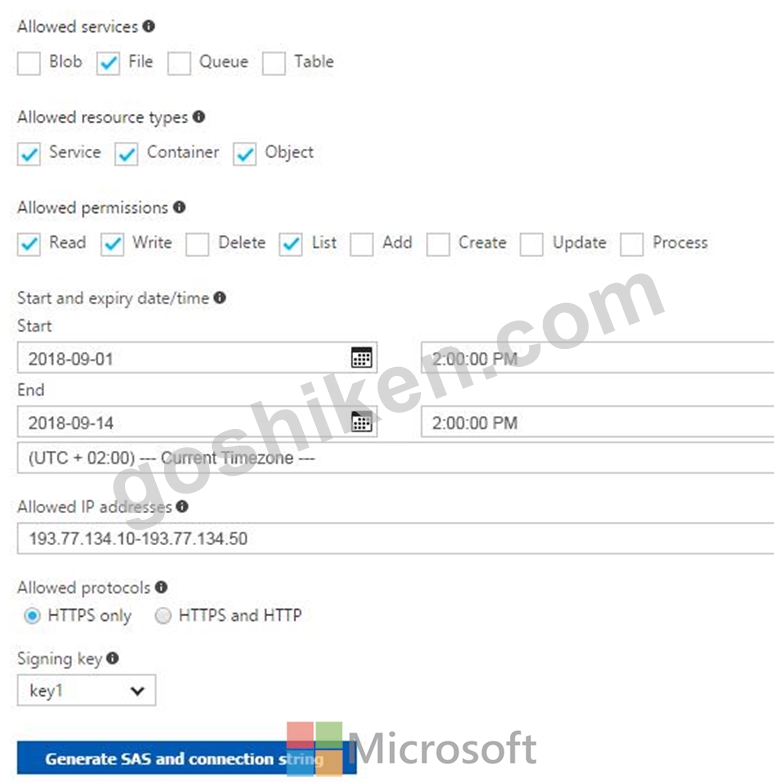
To answer, select the appropriate options in the answer area.
NOTE: Each correct selection is worth one point.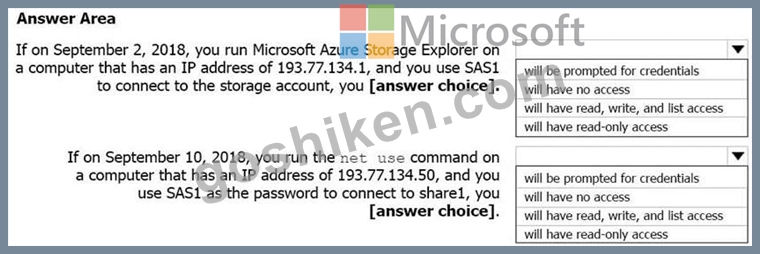
正解:
解説: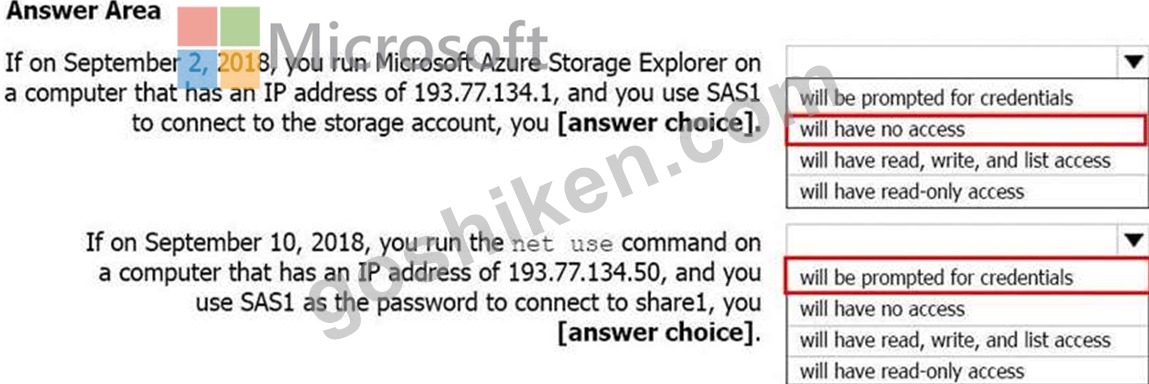
Reference:
https://docs.microsoft.com/en-us/azure/vs-azure-tools-storage-manage-with-storage-explorer?tabs=windows
https://feedback.azure.com/forums/217298-storage/suggestions/14498352-allow-azure-files-shares-to-be-mounted-using-sas-s
https://docs.microsoft.com/en-us/azure/storage/common/storage-sas-overview
https://docs.microsoft.com/en-us/azure/storage/files/storage-how-to-use-files-windows
http://www.rebeladmin.com/2018/03/step-step-guide-create-azure-file-share-map-windows-10/
質問 # 151
You have an Azure Linux virtual machine that is protected by Azure Backup.
One week ago, two files were deleted from the virtual machine.
You need to restore the deleted files to an on-premises computer as quickly as possible.
Which four actions should you perform in sequence? To answer, move the appropriate actions from the list of actions to the answer area and arrange them in the correct order.
正解:
解説:
Explanation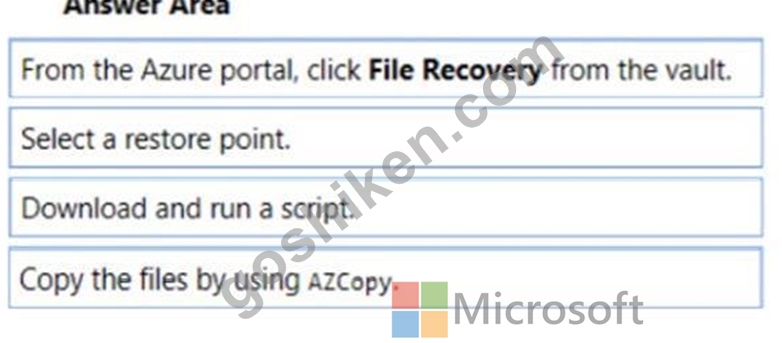
To restore files or folders from the recovery point, go to the virtual machine and choose the desired recovery point.
Step 0. In the virtual machine's menu, click Backup to open the Backup dashboard.
Step 1. In the Backup dashboard menu, click File Recovery.
Step 2. From the Select recovery point drop-down menu, select the recovery point that holds the files you want. By default, the latest recovery point is already selected.
Step 3: To download the software used to copy files from the recovery point, click Download Executable (for Windows Azure VM) or Download Script (for Linux Azure VM, a python script is generated).
Step 4: Copy the files by using AzCopy
AzCopy is a command-line utility designed for copying data to/from Microsoft Azure Blob, File, and Table storage, using simple commands designed for optimal performance. You can copy data between a file system and a storage account, or between storage accounts.
References:
https://docs.microsoft.com/en-us/azure/backup/backup-azure-restore-files-from-vm
https://docs.microsoft.com/en-us/azure/storage/common/storage-use-azcopy
質問 # 152
You have an Azure virtual machine named VM1 and a Recovery Services vault named Vault1.
You create a backup Policy1 as shown in the exhibit. (Click the Exhibit tab.)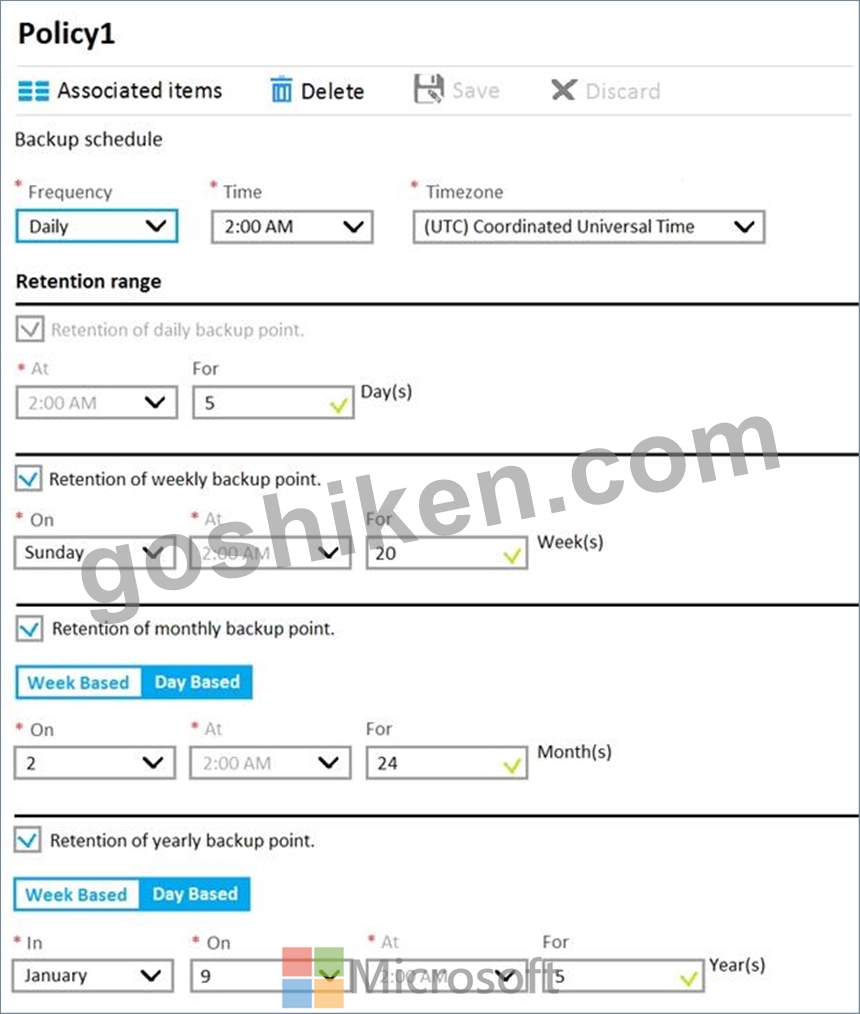
You configure the backup of VM1 to use Policy1 on Thursday, January 1.
You need to identify the number of available recovery points for VM1.
How many recovery points are available on January 8 and on January 15? To answer, select the appropriate options in the answer area.
NOTE: Each correct selection is worth one point.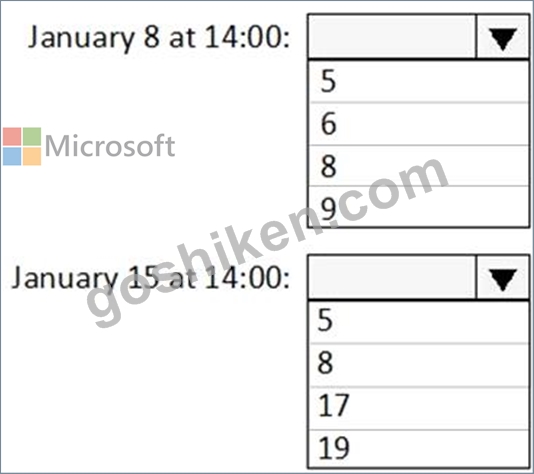
正解:
解説: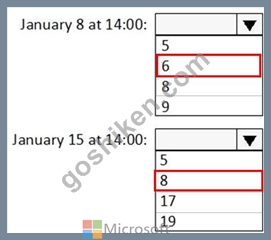
質問 # 153
You have an Azure subscription. The subscription contains virtual machines that run Windows Server 2016 and are configured as shown in the following table.

正解:
解説:
Explanation
質問 # 154
You have an Azure subscription named Subscription1 that contains the resources shown in the following table.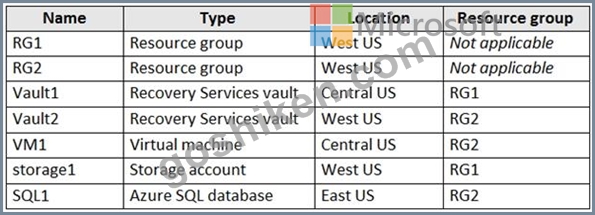
In storage1, you create a blob container named blob1 and a file share named share1.
Which resources can be backed up to Vault1 and Vault2? To answer, select the appropriate options in the answer area.
NOTE: Each correct selection is worth one point.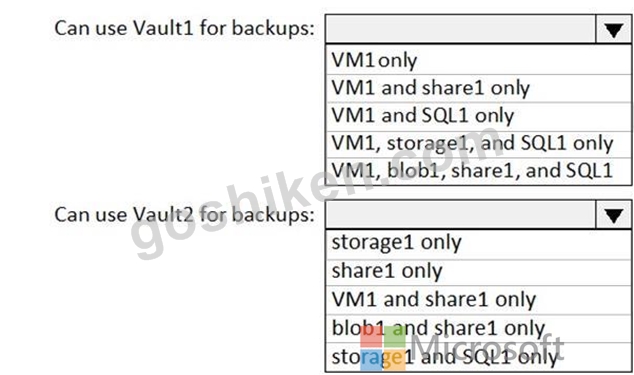
正解:
解説: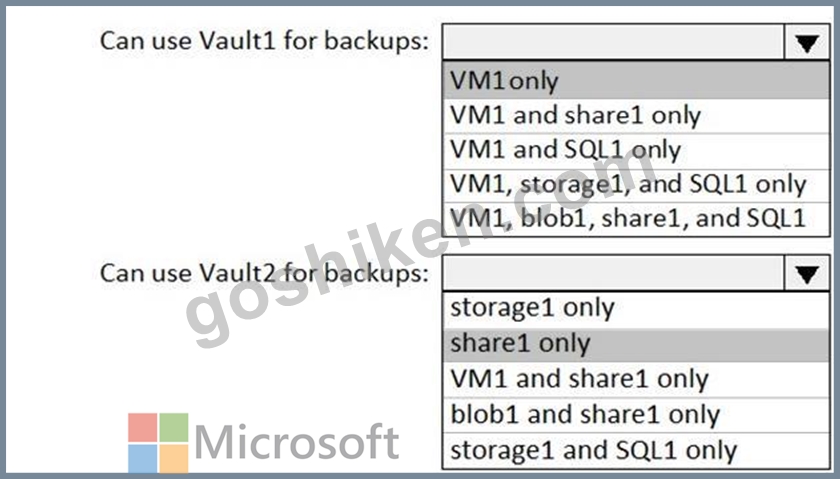
Box 1: VM1 only
VM1 is in the same region as Vault1.
File1 is not in the same region as Vautl1.
SQL is not in the same region as Vault1.
Blobs cannot be backup up to service vaults.
Note: To create a vault to protect virtual machines, the vault must be in the same region as the virtual machines.
Box 2: Share1 only.
Storage1 is in the same region (West USA) as Vault2. Share1 is in Storage1.
Note: After you select Backup, the Backup pane opens and prompts you to select a storage account from a list of discovered supported storage accounts. They're either associated with this vault or present in the same region as the vault, but not yet associated to any Recovery Services vault.
References:
https://docs.microsoft.com/bs-cyrl-ba/azure/backup/backup-create-rs-vault
https://docs.microsoft.com/en-us/azure/backup/backup-afs
質問 # 155
You have an Azure Kubernetes Service (AKS) cluster named AKS1.
You need to configure cluster autoscaler for AKS1.
Which two tools should you use? Each correct answer presents a complete solution,
NOTE: Each correct selection is worth one point
- A. the kubect1 command
- B. the set Azvm cmdlet
- C. the set-AzAKs cmdlet
- D. The az aks command
- E. the Azure portal
正解:A、E
質問 # 156
You have an Azure Linux virtual machine that is protected by Azure Backup.
One week ago, two files were deleted from the virtual machine.
You need to reses clients connect n on-premises computer as quickly as possible.
Which four actions should you perform in sequence? To answer, move the appropriate actions from the list of actions to the answer area and arrange them in the correct order.
正解:
解説: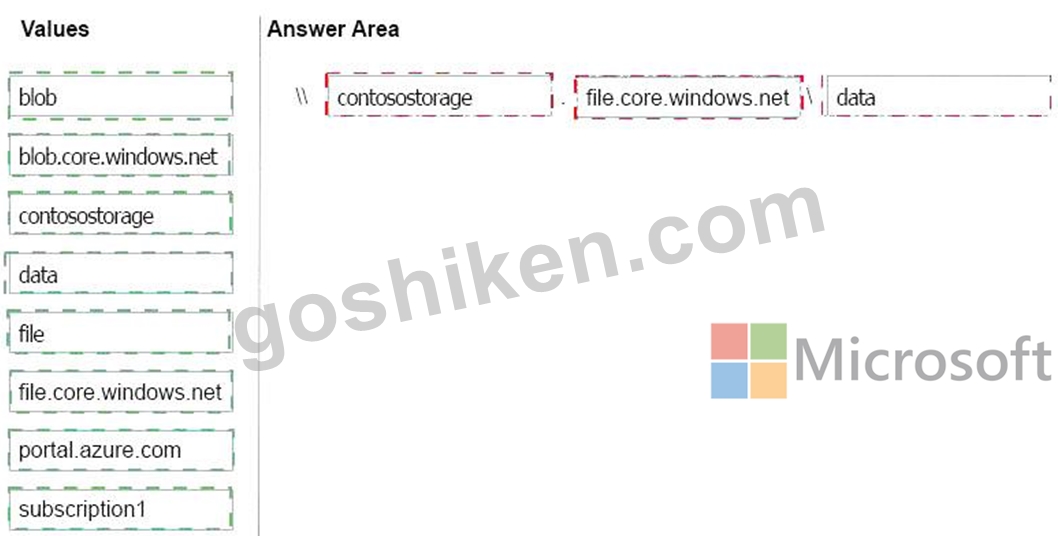
Explanation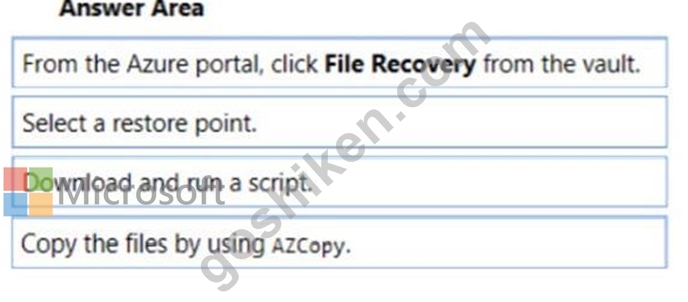
To restore files or folders from the recovery point, go to the virtual machine and choose the desired recovery point.
Step 0. In the virtual machine's menu, click Backup to open the Backup dashboard.
Step 1. In the Backup dashboard menu, click File Recovery.
Step 2. From the Select recovery point drop-down menu, select the recovery point that holds the files you want. By default, the latest recovery point is already selected.
Step 3: To download the software used to copy files from the recovery point, click Download Executable (for Windows Azure VM) or Download Script (for Linux Azure VM, a python script is generated).
Step 4: Copy the files by using AzCopy
AzCopy is a command-line utility designed for copying data to/from Microsoft Azure Blob, File, and Table storage, using simple commands designed for optimal performance. You can copy data between a file system and a storage account, or between storage accounts.
References:
https://docs.microsoft.com/en-us/azure/backup/backup-azure-restore-files-from-vm
https://docs.microsoft.com/en-us/azure/storage/common/storage-use-azcopy
質問 # 157
You have an Azure subscription named Subscription1. Subscription1 contains a virtual machine named VM1.
You have a computer named Computer1 that runs Windows 10. Computer1 is connected to the Internet.
You add a network interface named Interface1 to VM1 as shown in the exhibit (Click the Exhibit button.)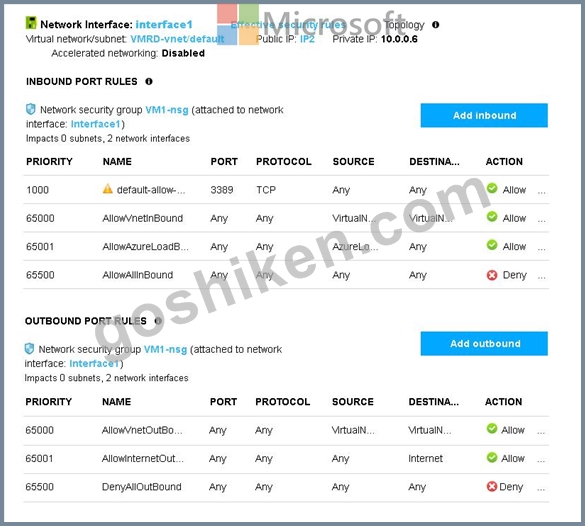
From Computer1, you attempt to connect to VM1 by using Remote Desktop, but the connection fails.
You need to establish a Remote Desktop connection to VM1.
What should you do first?
- A. Delete the DenyAllInBound inbound port rule.
- B. Attach a network interface.
- C. Start VM1.
- D. Delete the DenyAllOutBound outbound port rule.
正解:C
解説:
Note: Rules are processed in priority order, with lower numbers processed before higher numbers, because lower numbers have higher priority. Once traffic matches a rule, processing stops. As a result, any rules that exist with lower priorities (higher numbers) that have the same attributes as rules with higher priorities are not processed.
References: https://docs.microsoft.com/en-us/azure/virtual-network/security-overview
質問 # 158
You have an Azure virtual machine that runs Windows Server 2019 and has the following configurations:
* Name: VM1
* Location: West US
* Connected to: VNET1
* Private IP address: 10.1.0.4
* Public IP address: 52.186.85.63
* DNS suffix in Windows Server: Adatum.com
You create the Azure DNS zones shown in the following table.
You need to identify which DNS zones you can link to VNET1 and the DNS zones to which VM1 can automatically register.
Which zones should you identify? To answer, select the appropriate options in the answer area.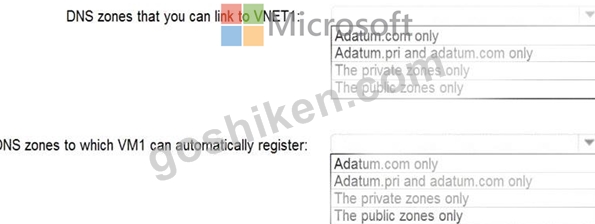
正解:
解説: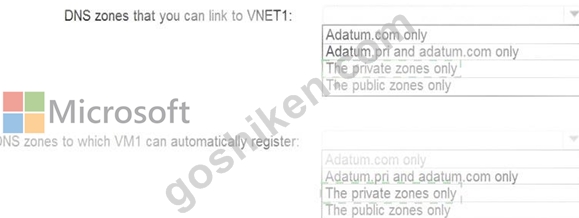
Explanation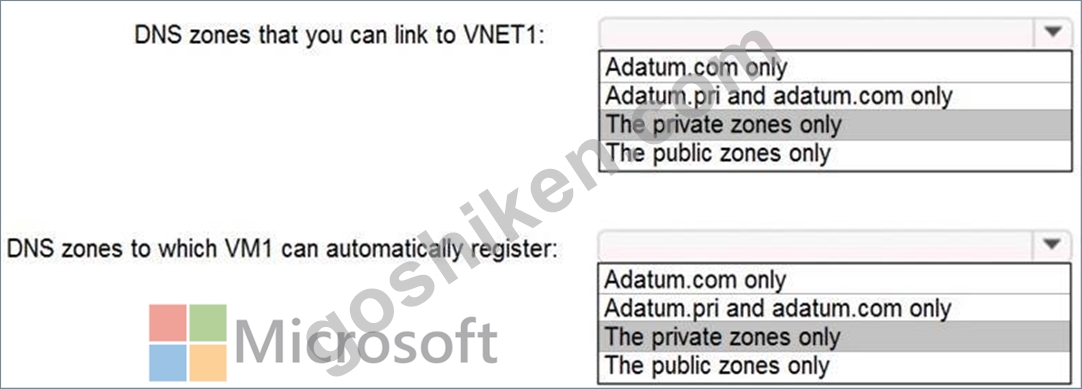
Reference:
https://docs.microsoft.com/en-us/azure/dns/private-dns-overview
質問 # 159
You have an Azure subscription that contains three virtual networks named VNet1, VNet2, VNet3. VNet2 contains a virtual appliance named VM2 that operates as a router.
You are configuring the virtual networks in a hub and spoke topology that uses VNet2 as the hub network.
You plan to configure peering between VNet1 and VNet2 and between VNet2 and VNet3.
You need to provide connectivity between VNet1 and VNet3 through VNet2.
Which two configurations should you perform? Each correct answer presents part of the solution.
NOTE: Each correct selection is worth one point.
- A. On the peering connections, allow gateway transit.
- B. On the peering connections, allow forwarded traffic.
- C. On the peering connections, use remote gateways.
- D. Create a route filter.
- E. Create route tables and assign the table to subnets.
正解:B、E
解説:
Allow gateway transit: Check this box if you have a virtual network gateway attached to this virtual network and want to allow traffic from the peered virtual network to flow through the gateway.
The peered virtual network must have the Use remote gateways checkbox checked when setting up the peering from the other virtual network to this virtual network.
Reference:
https://docs.microsoft.com/en-us/azure/virtual-network/virtual-network-manage-peering#requirements-andconstraints
質問 # 160
You are evaluating the connectivity between the virtual machines after the planned implementation of the Azure networking infrastructure.
For each of the following statements, select Yes if the statement is true. Otherwise, select No.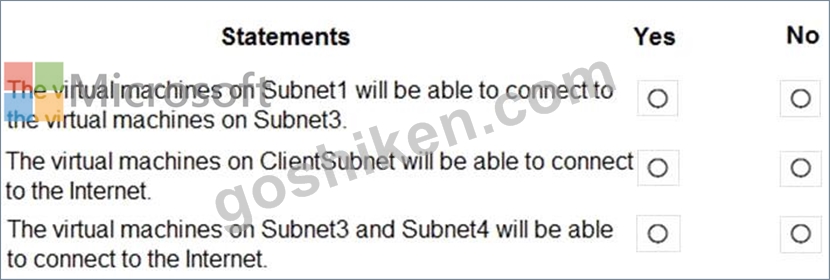
正解:
解説:
Explanation
質問 # 161
You have an Azure web app named App1 that has two deployment slots named Production and Staging. Each slot has the unique settings shown in the following table.
You perform a slot swap.
What are the configurations of the Production slot after the swap? To answer, select the appropriate options in the answer area.
NOTE: Each correction is worth one point.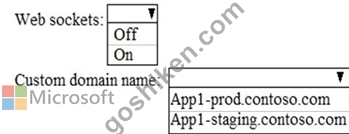
正解:
解説: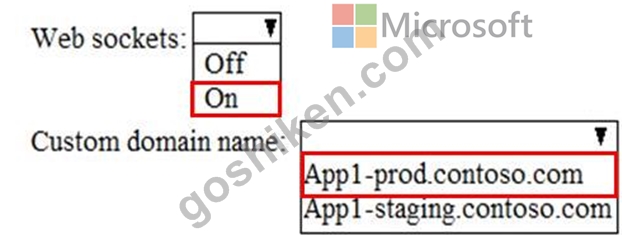
Explanation:
Which settings are swapped?
When you clone configuration from another deployment slot, the cloned configuration is editable. Some configuration elements follow the content across a swap (not slot specific), whereas other configuration elements stay in the same slot after a swap (slot specific). The following lists show the settings that change when you swap slots.
Box 1 : On
Settings that are swapped:
General settings, such as framework version, 32/64-bit, web sockets
App settings (can be configured to stick to a slot)
Connection strings (can be configured to stick to a slot)
Handler mappings
Public certificates
WebJobs content
Hybrid connections *
Virtual network integration *
Service endpoints *
Azure Content Delivery Network *
Features marked with an asterisk (*) are planned to be unswapped.
So web sockets settings will be swapped. So Production will have web sockets settings from "Off" to "On" after the swap slot.
Box 2: App1-prod.contoso.com
Settings that aren't swapped:
Publishing endpoints
Custom domain names
Non-public certificates and TLS/SSL settings
Scale settings
WebJobs schedulers
IP restrictions
Always On
Diagnostic settings
Cross-origin resource sharing (CORS)
So Custom domain names will not be swapped. So Production will have Custom domain names of its own after the swap slot.
Reference:
https://docs.microsoft.com/en-us/azure/app-service/deploy-staging-slots#what-happens-during-a-swap
質問 # 162
You need to prepare the environment to meet the authentication requirements.
Which two actions should you perform? Each correct answer presents part of the solution.
NOTE: Each correct selection is worth one point.
- A. Install Azure AD Connect on a server in the Miami office and enable Pass-through Authentication.
- B. Add http://autogon.microsoftazuread-sso.com to the intranet zone of each client computer in the Miami office.
- C. Allow inbound TCP port 8080 to the domain controllers in the Miami office.
- D. Install the Active Directory Federation Services (AD FS) role on a domain controller in the Miami office.
- E. Join the client computers in the Miami office to Azure AD.
正解:A、B
解説:
B: You can gradually roll out Seamless SSO to your users. You start by adding the following Azure AD URL to all or selected users' Intranet zone settings by using Group Policy in Active Directory: https://autologon.microsoftazuread-sso.com E: Seamless SSO works with any method of cloud authentication - Password Hash Synchronization or Pass-through Authentication, and can be enabled via Azure AD Connect.
References:
https://docs.microsoft.com/en-us/azure/active-directory/hybrid/how-to-connect-sso-quick-start
Topic 3, Contoso Ltd
Overview
Contoso, Ltd. is a manufacturing company that has offices worldwide. Contoso works with partner organizations to bring products to market.
Contoso products are manufactured by using blueprint files that the company authors and maintains.
Existing Environment
Currently, Contoso uses multiple types of servers for business operations, including the following:
* File servers
* Domain controllers
* Microsoft SQL Server servers
Your network contains an Active Directory forest named contoso.com. All servers and client computers are joined to Active Directory.
You have a public-facing application named App1. App1 is comprised of the following three tiers:
* A SQL database
* A web front end
* A processing middle tier
Each tier is comprised of five virtual machines. Users access the web front end by using HTTPS only.
Requirements
Planned Changes
Contoso plans to implement the following changes to the infrastructure:
Move all the tiers of App1 to Azure.
Move the existing product blueprint files to Azure Blob storage.
Create a hybrid directory to support an upcoming Microsoft Office 365 migration project.
Technical Requirements
Contoso must meet the following technical requirements:
* Move all the virtual machines for App1 to Azure.
* Minimize the number of open ports between the App1 tiers.
* Ensure that all the virtual machines for App1 are protected by backups.
* Copy the blueprint files to Azure over the Internet.
* Ensure that the blueprint files are stored in the archive storage tier.
* Ensure that partner access to the blueprint files is secured and temporary.
* Prevent user passwords or hashes of passwords from being stored in Azure.
* Use unmanaged standard storage for the hard disks of the virtual machines.
* Ensure that when users join devices to Azure Active Directory (Azure AD), the users use a mobile phone to verify their identity.
Minimize administrative effort whenever possible.
User Requirements
Contoso identifies the following requirements for users:
Ensure that only users who are part of a group named Pilot can join devices to Azure AD.
Designate a new user named Admin1 as the service administrator of the Azure subscription.
Ensure that a new user named User3 can create network objects for the Azure subscription.
質問 # 163
Note: This question is part of a series of questions that present the same scenario. Each question in the series contains a unique solution that might meet the stated goals. Some question sets might have more than one correct solution, while others might not have a correct solution.
After you answer a question in this section, you will NOT be able to return to it. As a result, these questions will not appear in the review screen.
You have an Azure subscription named Subscription1 that contains the resources shown in the following table.
VM1 connects to a virtual network named VNET2 by using a network interface named NIC1.
You need to create a new network interface named NIC2 for VM1.
Solution: You create NIC2 in RG2 and Central US.
Does this meet the goal?
- A. No
- B. Yes
正解:A
解説:
Explanation
The virtual machine you attach a network interface to and the virtual network you connect it to must exist in the same location, here West US, also referred to as a region.
References:
https://docs.microsoft.com/en-us/azure/virtual-network/virtual-network-network-interface
質問 # 164
You have a resource group named RG1. RG1 contains an Azure Storage account named storageaccount1 and a virtual machine named VM1 that runs Windows Server 2016. Storageaccount1 contains the disk files for VM1. You apply a ReadOnly lock to RG1.
What can you do from the Azure portal?
- A. Upload a blob to storageaccount1.
- B. View the keys of storageaccount1.
- C. Start VM1.
- D. Generate an automation script for RG1.
正解:A
解説:
Applying locks can lead to unexpected results because some operations that don't seem to modify the resource actually require actions that are blocked by the lock. Locks are inherited to all of its resources if it applies on resource group level.
Upload a blob to storageaccount1 is possible if we have readonly lock on RG1 since we are trying to modify the data not resource properties.
When a R/O lock is put on a resource, you lock it's properties not the resource. So while a read only lock is present on a storage account(inherited from a resource group), a file can still be uploaded to the already existing container of a storage account.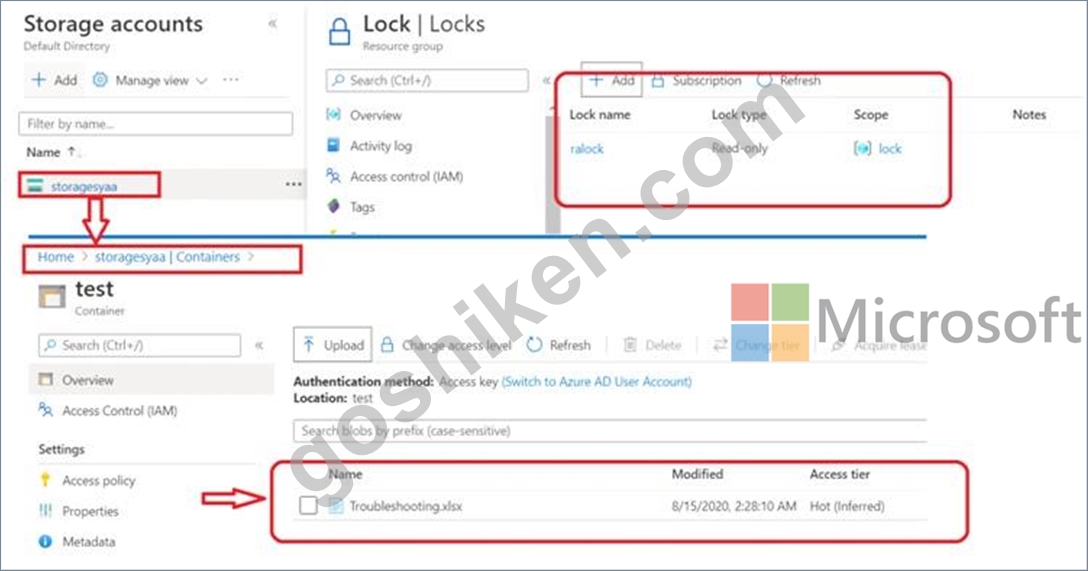
Incorrect Answers:
Generate an automation script for RG1 is NOT possible in read only mode.
A read-only lock on a storage account prevents all users from listing the keys. The list keys operation is handled through a POST request because the returned keys are available for write operations. When we tried to read the Access Key of the Storage Account , get the below message.
Access blocked The resource is locked Cannot access the data plane because of a read lock on the resource or its parent.
A read-only lock on a resource group that contains a virtual machine prevents all users from starting or restarting the virtual machine. These operations require a POST request.
References:
https://docs.microsoft.com/en-us/azure/azure-resource-manager/management/lock-resources
質問 # 165
You have an Azure subscription.
You have an on-premises virtual machine named VM1. The settings for VM1 are shown in the exhibit. (Click the Exhibit button.)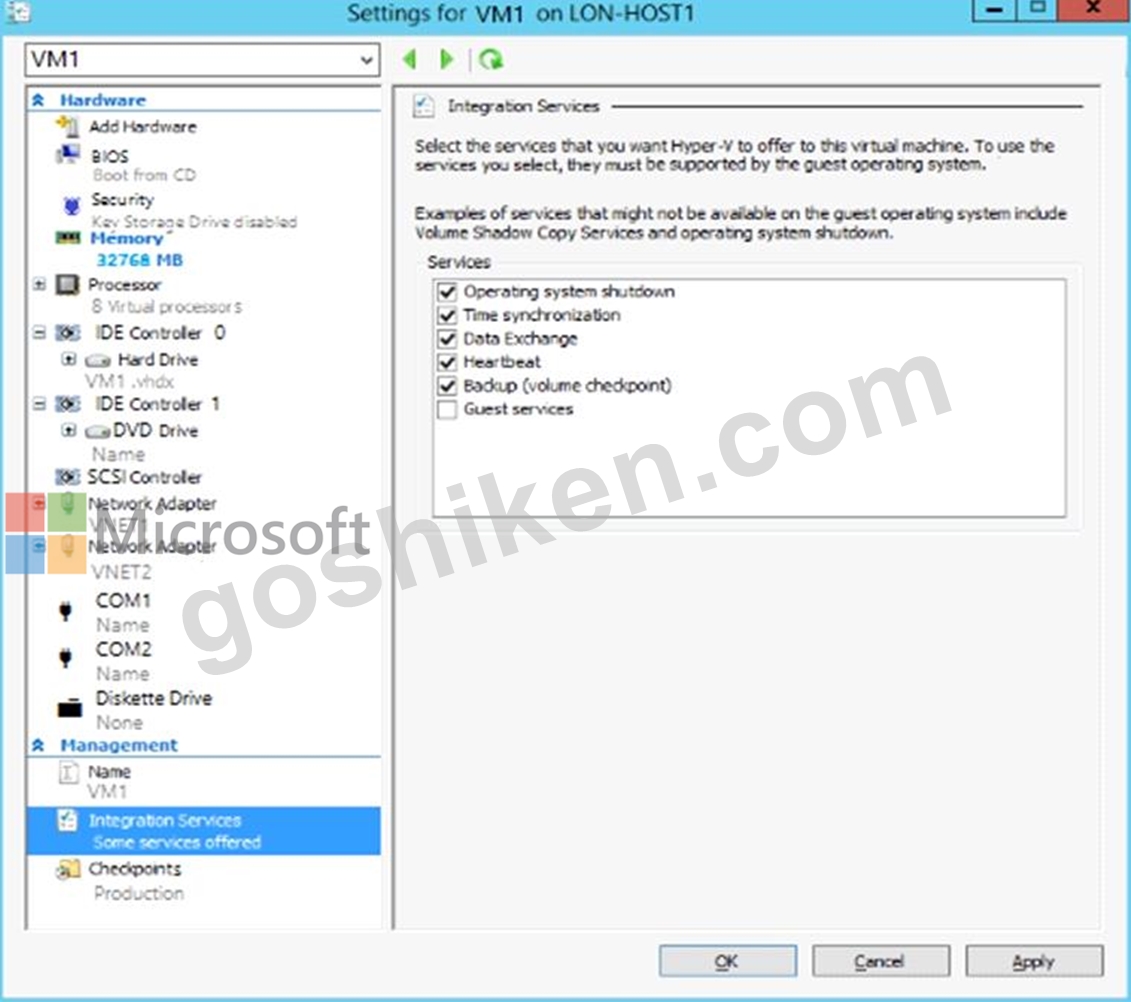
You need to ensure that you can use the disks attached to VM1 as a template for Azure virtual machines.
What should you modify on VM1?
- A. the network adapters
- B. Integration Services
- C. the memory
- D. the processor
- E. the hard drive
正解:E
解説:
From the exhibit we see that the disk is in the VHDX format.
Before you upload a Windows virtual machines (VM) from on-premises to Microsoft Azure, you must prepare the virtual hard disk (VHD or VHDX). Azure supports only generation 1 VMs that are in the VHD file format and have a fixed sized disk. The maximum size allowed for the VHD is 1,023 GB. You can convert a generation 1 VM from the VHDX file system to VHD and from a dynamically expanding disk to fixed-sized.
References:
https://docs.microsoft.com/en-us/azure/virtual-machines/windows/prepare-for-upload-vhd-image?toc=%2fazure%2fvirtual-machines%2fwindows%2ftoc.json
質問 # 166
You have an Azure subscription named Sub1.
You plan to deploy a multi-tiered application that will contain the tiers shown in the following table.
You need to recommend a networking solution to meet the following requirements:
Ensure that communication between the web servers and the business logic tier spreads equally across the virtual machines.
Protect the web servers from SQL injection attacks.
Which Azure resource should you recommend for each requirement? To answer, select the appropriate options in the answer area.
NOTE: Each correct selection is worth one point.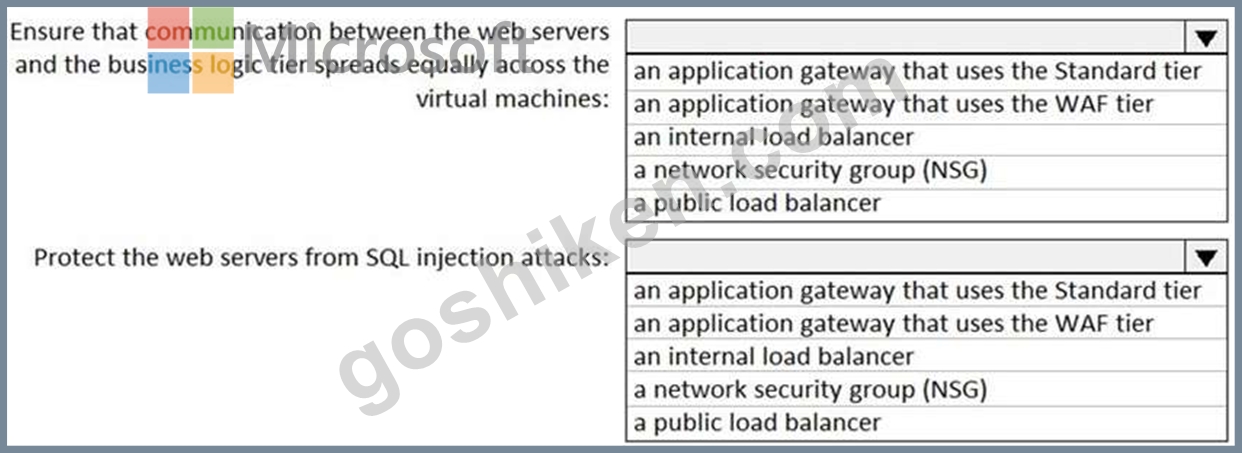
正解:
解説: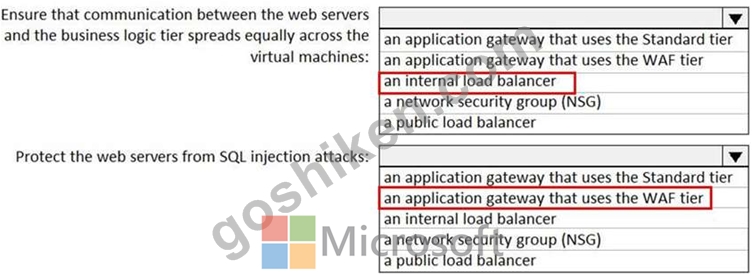
Reference:
https://docs.microsoft.com/en-us/azure/web-application-firewall/ag/ag-overview
質問 # 167
You have an Azure subscription. The subscription includes a virtual network named VNet1. Currently, VNet1 does not contain any subnets.
You plan to create subnets on VNet1 and to use application security groups to restrict the traffic between the subnets. You need to create the application security groups and to assign them to the subnets.
Which four cmdlets should you run in sequence? To answer, move the appropriate cmdlets from the list of cmdlets to the answer area and arrange them in the correct order.
正解:
解説:
Explanation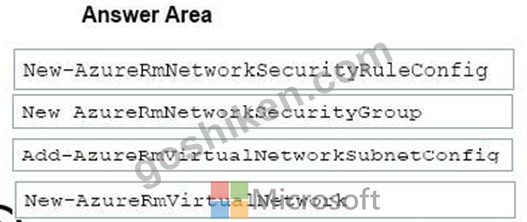
Step 1: New-AzureRmNetworkSecurityRuleConfig
Step 2: New-AzureRmNetworkSecurityGroup
Step 3: New-AzureRmVirtualNetworkSubnetConfig
Step 4: New-AzureRmVirtualNetwork
Example: Create a virtual network with a subnet referencing a network security group New-AzureRmResourceGroup -Name TestResourceGroup -Location centralus
$rdpRule = New-AzureRmNetworkSecurityRuleConfig -Name rdp-rule -Description "Allow RDP" -Access Allow -Protocol Tcp -Direction Inbound -Priority 100 -SourceAddressPrefix Internet -SourcePortRange *
-DestinationAddressPrefix * -DestinationPortRange 3389
$networkSecurityGroup = New-AzureRmNetworkSecurityGroup -ResourceGroupName TestResourceGroup
-Location centralus -Name "NSG-FrontEnd" -SecurityRules $rdpRule
$frontendSubnet = New-AzureRmVirtualNetworkSubnetConfig -Name frontendSubnet -AddressPrefix
"10.0.1.0/24" -NetworkSecurityGroup $networkSecurityGroup
$backendSubnet = New-AzureRmVirtualNetworkSubnetConfig -Name backendSubnet -AddressPrefix
"10.0.2.0/24" -NetworkSecurityGroup $networkSecurityGroup
New-AzureRmVirtualNetwork -Name MyVirtualNetwork -ResourceGroupName TestResourceGroup
-Location centralus -AddressPrefix "10.0.0.0/16" -Subnet $frontendSubnet,$backendSubnet References:
https://docs.microsoft.com/en-us/powershell/module/azurerm.network/new-azurermvirtualnetwork?view=azurer
質問 # 168
You have an Azure subscription that contains an Azure Availability Set named WEBPROD-AS-USE2 as shown in the following exhibit.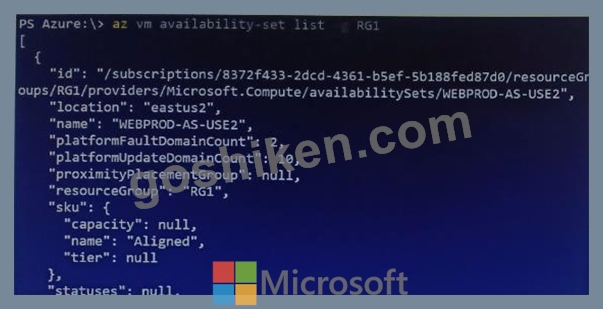

You add 14 virtual machines to WEBPROD-AS-USE2.
Use the drop-down menus to select the answer choice that completes each statement based on the information presented in the graphic.
NOTE: Each correct selection is worth one point.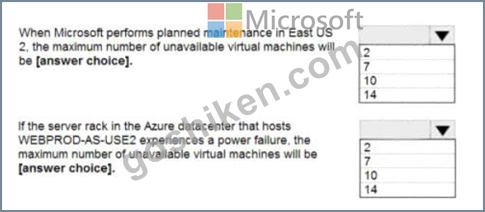
正解:
解説: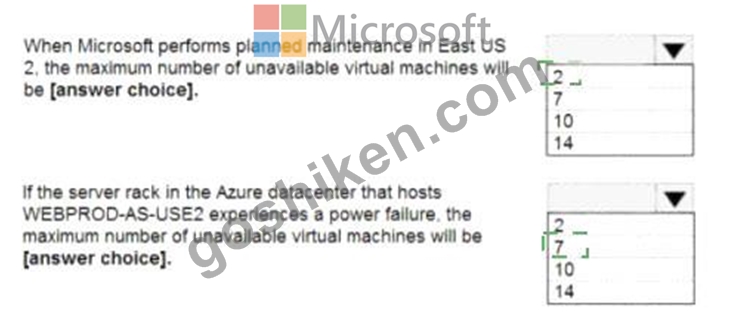
Explanation
Box 1: 2
There are 10 update domains. The 14 VMs are shared across the 10 update domains so four update domains will have two VMs and six update domains will have one VM. Only one update domain is rebooted at a time.
Therefore, a maximum of two VMs will be offline.
Box 2: 7
There are 2 fault domains. The 14 VMs are shared across the 2 fault domains, so 7 VMs in each fault domain.
A rack failure will affect one fault domain so 7 VMs will be offline.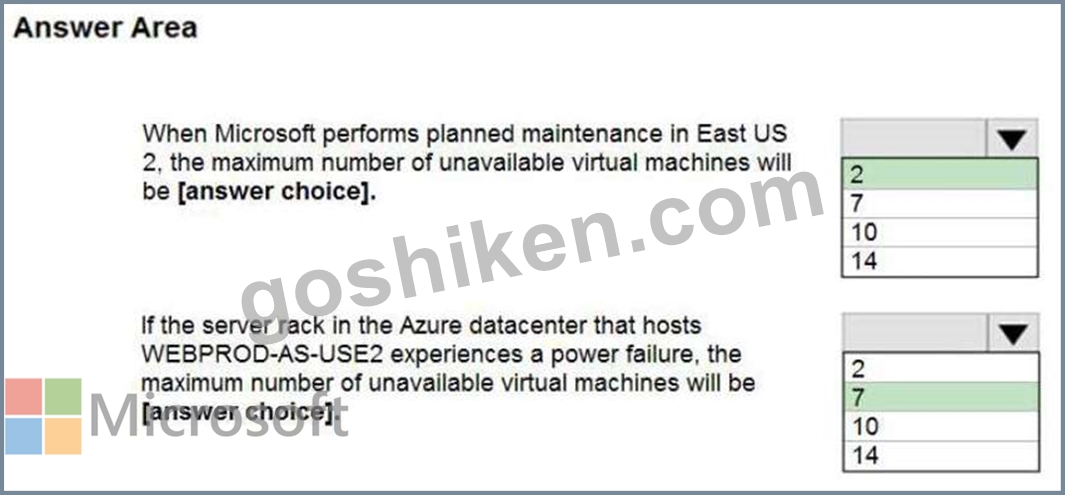
Reference:
https://docs.microsoft.com/en-us/azure/virtual-machines/windows/manage-availability
質問 # 169
You are evaluating the connectivity between the virtual machines after the planned implementation of the Azure networking infrastructure.
For each of the following statements, select Yes if the statement is true. Otherwise, select No.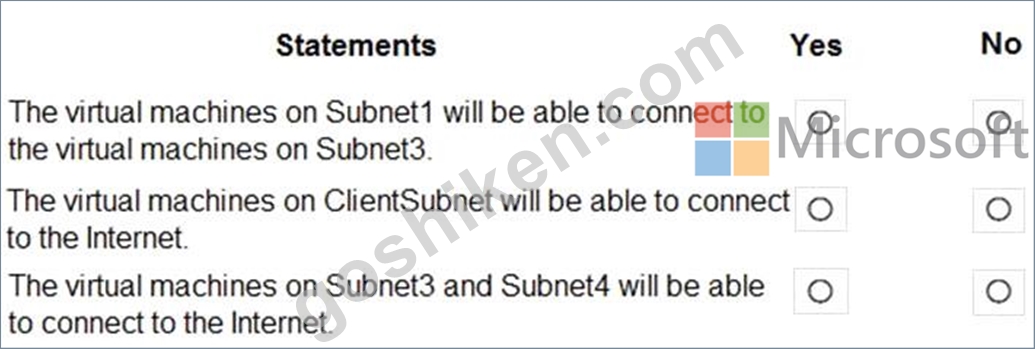
正解:
解説: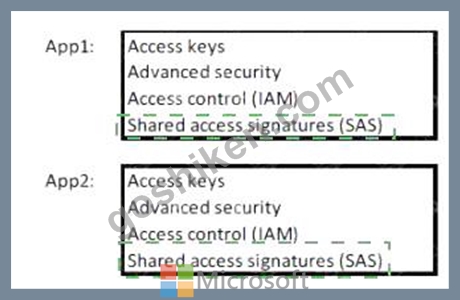
Explanation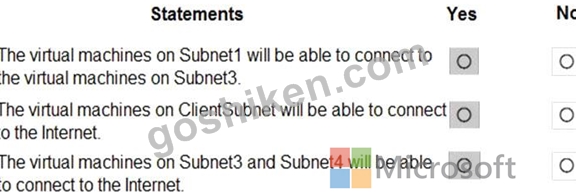
Once the VNets are peered, all resources on one VNet can communicate with resources on the other peered VNets. You plan to enable peering between Paris-VNet and AllOffices-VNet. Therefore VMs on Subnet1, which is on Paris-VNet and VMs on Subnet3, which is on AllOffices-VNet will be able to connect to each other.
All Azure resources connected to a VNet have outbound connectivity to the Internet by default. Therefore VMs on ClientSubnet, which is on ClientResources-VNet will have access to the Internet; and VMs on Subnet3 and Subnet4, which are on AllOffices-VNet will have access to the Internet.
Reference:
https://docs.microsoft.com/en-us/azure/virtual-network/virtual-network-peering-overview
https://docs.microsoft.com/en-us/azure/networking/networking-overview#internet-connectivity
質問 # 170
Note: This question is part of a series of questions that present the same scenario. Each question in the series contains a unique solution that might meet the stated goals. Some question sets might have more than one correct solution, while others might not have a correct solution.
After you answer a question in this section, you will NOT be able to return to it. As a result, these questions will not appear in the review screen.
You have an Azure subscription named Subscription1. Subscription1 contains a resource group named RG1.
RG1 contains resources that were deployed by using templates.
You need to view the date and time when the resources were created in RG1.
Solution: From the RG1 blade, you click Deployments.
Does this meet the goal?
- A. Yes
- B. No
正解:A
解説:
Explanation
1. Select the resource group (Here RG1) you want to examine.
2. Select the link under Deployments.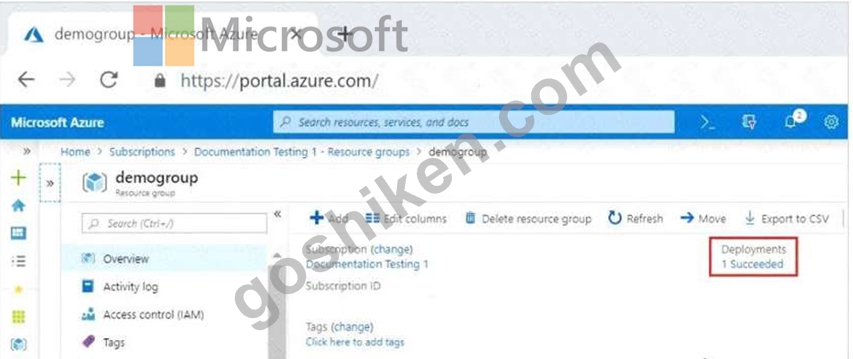
3. Select one of the deployments from the deployment history.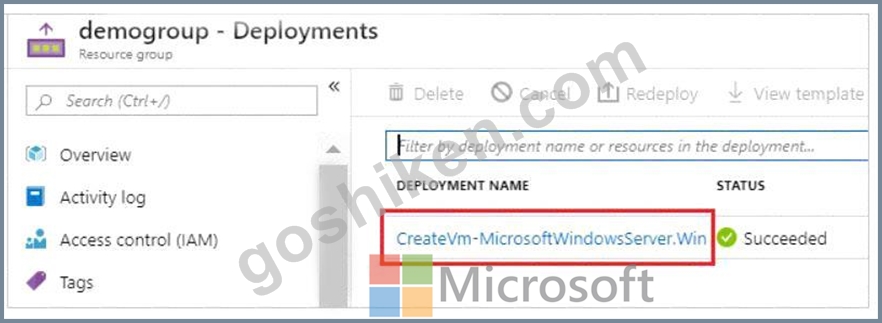
4. You will see a history of deployment for the resource group, including the correlation ID.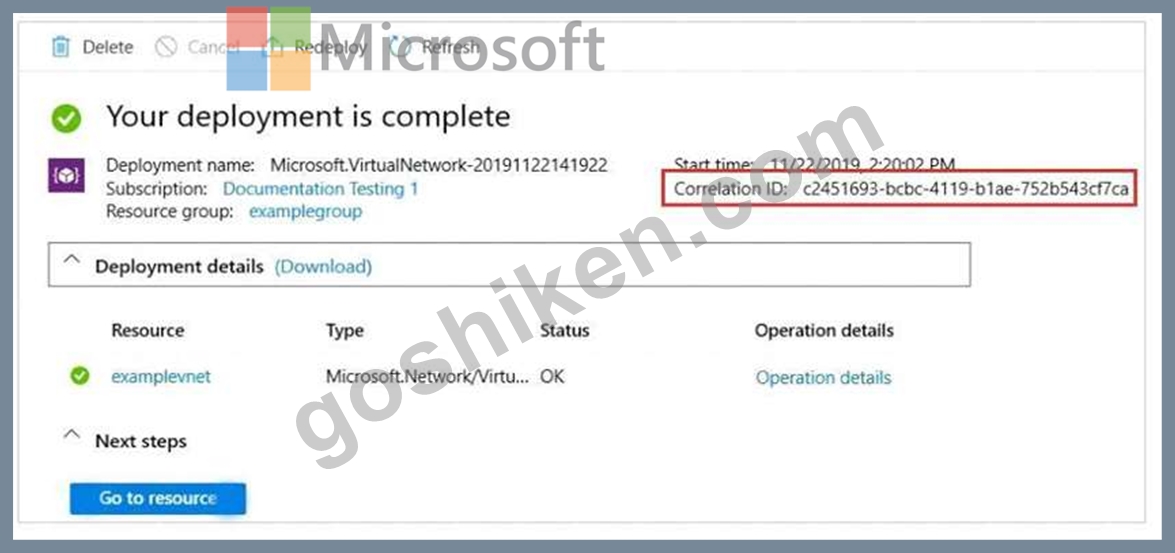
Reference:
https://docs.microsoft.com/en-us/azure/azure-resource-manager/templates/deployment-history?tabs=azure-portal
質問 # 171
......
最新のAZ-104試験問題集でMicrosoft試験が合格できます:https://www.goshiken.com/Microsoft/AZ-104-mondaishu.html
